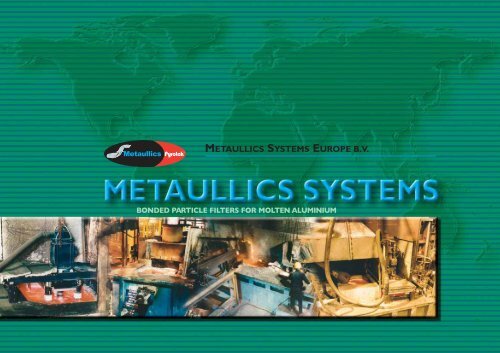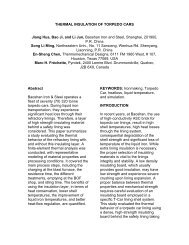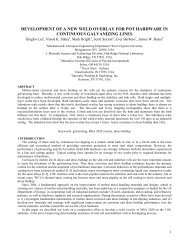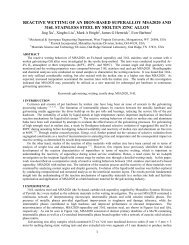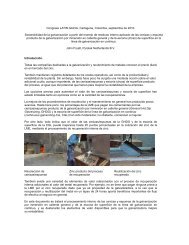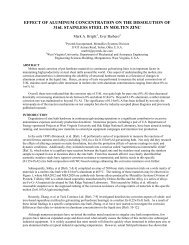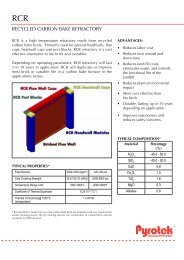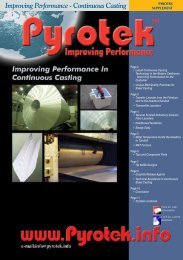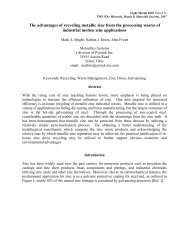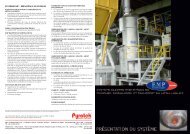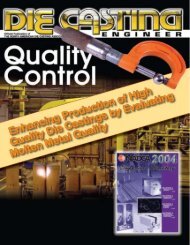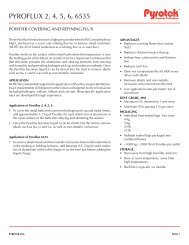Bonded Particle Filter - Pyrotek
Bonded Particle Filter - Pyrotek
Bonded Particle Filter - Pyrotek
You also want an ePaper? Increase the reach of your titles
YUMPU automatically turns print PDFs into web optimized ePapers that Google loves.
BONDED PARTICLE FILTERS FOR MOLTEN ALUMINIUM
METAULLICS SYSTEMS<br />
Metaullics Systems, headquartered in Solon, Ohio, USA is a<br />
division of <strong>Pyrotek</strong>, Inc., which is a privately owned company with<br />
headquarters in Spokane,Washington, USA.<br />
<strong>Pyrotek</strong> specialises in the development, manufacture and supply of<br />
high temperature materials, technologies and engineered systems<br />
for liquid metal management and associated metallurgical<br />
applications. Manufacturing units and sales offices are located in<br />
more than 60 worldwide locations and allow <strong>Pyrotek</strong> to offer<br />
outstanding customer service and supply logistics. Products<br />
include launder systems, distribution bowls, tundishes and<br />
specialised insulating shapes and filters.<br />
Metaullics is a global supplier of molten metal pumps, distribution<br />
systems, alloying systems and scrap and waste recovery systems,<br />
filtration systems for all sectors of the Aluminium industry.<br />
Metaullics Systems Europe, with headquarters in The Netherlands<br />
provides local application engineering, customer service and<br />
warehousing facilities for Europe and The Middle East.<br />
1. SUPERIOR FILTER MEDIA<br />
FROM METAULLICS<br />
It gives you the benefits of clean aluminium – reliably and<br />
economically.<br />
Molten aluminium normally contains various solid-phase<br />
inclusions, such as oxides, borides, carbides and spinels, and<br />
refractory particles from vessel erosion. If allowed to remain,<br />
these contaminants adversely affect the characteristics of the<br />
metal in its final, solidified form.<br />
Impact of Inclusions on Final Product Quality<br />
Reduced extrusion die life<br />
Surface streaks<br />
in bright<br />
automotive<br />
trim<br />
Poor<br />
surface<br />
finish<br />
Flange<br />
cracks in<br />
beverage cans<br />
Inclusion<br />
Generated<br />
Defects<br />
Reduced mechanical strength, ductility, fatige resistance<br />
Effective filtering of molten (liquid) aluminium removes these<br />
contaminants and can also reduce inclusion-nucleated porosity.<br />
This not only improves product quality and lowers the reject rate,<br />
creating additional profit to cover the cost of filtration. In fact,<br />
filtration always adds value—never just cost!<br />
However, with some commercially available filters, problems like<br />
rapid head build-up, sudden contaminant release (dumping), filter<br />
breakage and even ineffective or unreliable filtration can occur.<br />
Precaution requires the use of superior media, plus special know-<br />
how and applications expertise to lower the effective cost of<br />
aluminium filtration and achieve maximum benefit.<br />
Poor machine<br />
ability<br />
Reduced<br />
brightness<br />
in<br />
anodised<br />
products<br />
Pinholes in<br />
light<br />
gauge foil
At Metaullics, we analyse your process in detail. Only then can we<br />
determine the correct filter and specify the proper shape, size and<br />
permeability for your specific application. Once this has been<br />
done, you can expect trouble-free service life from your<br />
Metaullics® filters.The media we use, bonded ceramic particulate,<br />
provides high filtration efficiency and excellent structural strength.<br />
Our media is used in selected wrought casthouse applications to<br />
produce semi-finished shapes, and in aluminium gravity casting<br />
(permanent mold), pressure diecasting, low pressure, squeeze cast<br />
and high-performance sand foundries.<br />
Because filtration of aluminium is a complex subject, we hope the<br />
information in this brochure will prove useful. Let’s begin with a<br />
look at what effective filtration should accomplish for you<br />
1.1 INCLUSIONS TO BE REMOVED<br />
Filtration is the separation of solids from liquids. Effective filtration<br />
should trap and hold the major contaminants that are commonly<br />
found in molten aluminium. Oxides of aluminium and magnesium<br />
are among the inclusions most frequently encountered. Of these<br />
Al2O3 is the most troublesome, because it is the most easily<br />
formed, hence, the most abundant. Furthermore, many inclusions<br />
have an effective specific gravity close to that of molten aluminium<br />
and tend to stay in suspension. Spinel, another kind of<br />
contaminant, is a complex oxide with a specific crystal structure<br />
and the general chemical formula of AB2O4 where A and B are<br />
metals. Common examples of spinels are MgAl2O4 and MnAl2O4.<br />
Other inclusions to be found include carbides (especially from<br />
primary aluminium production), nitrides, and refractory particles<br />
from wear and erosion. In foundry alloys, especially diecasting<br />
metal, intermetallic sludge particles (Fe-Mn-Cr complex) can<br />
cause ‘hardspots’ which cause machining difficulty. Additionally,<br />
recycled metal in any remelt operation always contains substantial<br />
oxide content
2. DEPENDABLE METAL CLEANLINESS WITHOUT PROBLEMS<br />
DEMANDS DEPENDABLE FILTER MEDIA<br />
2.1 WHAT FILTERING DOES FOR METAL QUALITY<br />
When effective, filtration substantially improves product unifor-<br />
mity. Figure 1a and 1b show the difference between a filtered and<br />
an unfiltered aluminium foil product.<br />
Figure 1a.<br />
Unfiltered aluminium<br />
foil product metal<br />
at 350X.<br />
Figure 1b.<br />
Foil alloy filtered<br />
through 10 grit<br />
Multicast<br />
MC-6 filter.<br />
Magnification 350X.<br />
<strong>Filter</strong>ing the molten metal results in significantly increased fluidity,<br />
which improves castability and helps to prolong mold life.<br />
Since inclusions, or hard spots, are minimised or eliminated, the<br />
metal is easier to form or machine and tool wear is reduced.<br />
With fewer casting defects, your yield and productivity are higher,<br />
as is overall product quality.<br />
Mechanical properties (tensile, yield, fatigue, creep and rupture<br />
strength) can often be improved with filtration, but elongation<br />
or ductility is especially sensitive to metal cleanliness, i.e. low<br />
inclusion levels achieved with filtration means higher ductility. For<br />
example, in extrusion billet casting, as shown in figure 2, the<br />
percentage of elongation can be greatly increased, even doubled in<br />
some cases.<br />
Improved surface finish results from inclusion removal, important<br />
for bright trim stock, cast wheels, or for any other surface finishing<br />
operations (anodizing, painting and plating). Filtration also reduces<br />
the rate of rejection and rework due to pinholes, linear defects or<br />
tear-out in foil and sheet product production.<br />
Figure 2.<br />
Effect of filtration on<br />
short transverse<br />
elongation of 7079-T6.
Filtration is especially beneficial in removing ‘hardspots’ (oxide and<br />
sludge inclusions) from net and near-net-shape foundry castings,<br />
resulting in significantly increased machinibility, less tool wear<br />
and less tool breakage! Clearly, gains in product quality, productivity<br />
and profitability make filtration a very necessary and desirable<br />
process for all aluminium casting applications.<br />
2.2 COMMERCIALLY AVAILABLE FILTER MEDIA<br />
Four major types of filters for aluminium are found in the<br />
marketplace. Along with their predominant characteristics, they<br />
are the following:<br />
A. Alumina bed filters<br />
Bed filters are comprised of ‘layers’ of tabular and ball alumina to<br />
create ‘depth’ as the metal flows between the ‘balls’ and flakes.<br />
The porosity of the bed is not fixed, however, so channelling of the<br />
aluminium flow can occur, either spontaneously through surge<br />
flow, or inadvertently through mechanical disturbances. This can<br />
lead to dumping of already-trapped inclusions and discharge of<br />
unfiltered metal. While deep-bed filters are usually large and fairly<br />
costly, they do provide excellent filtration if the life is not over-<br />
extended.<br />
B. Ceramic foam filters<br />
Ceramic foam filters are bonded or sintered alumina with<br />
porosity controlled during manufacture to provide a gradation<br />
of pore sizes 20 or 30 ppi, or grades 40, 50, 60, 65 and 80. With<br />
high average porosity (80-85%), fairly rapid metal flow rates can be<br />
achieved, but at the expense of filtration efficiency. With such high<br />
porosity, mechanical strength is relatively low, and handling<br />
damage or break-up may occur during melt flow. Providing the<br />
proper filter grade/flow relationship is maintained for an initial<br />
metal cleanliness, ceramic foam filters are low-cost and find their<br />
best application as a single-use (single-cast) application in the<br />
casthouse or foundry.<br />
C. <strong>Bonded</strong> ceramic particles<br />
This is the type of filter supplied by Metaullics - a bonded granular<br />
ceramic media, fabricated either from aluminium oxide or silicon<br />
carbide. The proprietary bonding agent employed is both strong<br />
and resistant to chemical attack by molten aluminium.<br />
Substantially lower porosity (nominally 40%) and the inherent<br />
properties of the hard alumina or silicon carbide granules<br />
provides a much stonger filter structure which aids in handling<br />
and durability. Especially with silicon carbide construction, thermal<br />
conductivity is substantially higher which aids in preheat and in<br />
thermal transfer. The complex, fully-interconnected internal pore<br />
structure provides a ‘tortuous path’ for metal flow. The bonding<br />
agent also has a particular affinity for inclusions. This combination<br />
of lower porosity, tortuous flow path and binder chemistry allows<br />
the Metaullics bonded particle filter to exhibit the best balance<br />
between cake-mode and depth-mode filtration.
D. Other filter media<br />
In addition to the preceding filter types, woven fiberglass and<br />
extruded ceramics may be used to filter aluminium.<br />
Non-rigid fiberglass socks or screens provide very coarse<br />
filtration through a sieve-like action. Inexpensive, they are used<br />
primarily as a coarse pre-filter after a taphole or where neces-<br />
sary to remove only the largest contaminants.<br />
Extruded ceramics have direct-channel openings where the outlet<br />
area is the same as the inlet area. Accordingly, they are used more<br />
for flow control and removal of large inclusion particulate, but are<br />
not very effective for many of the smaller but still undesirable<br />
inclusions often existing in aluminium melts.<br />
Figure 3 compares the features of the various filter types:<br />
High<br />
Temperature<br />
Strength<br />
Geometric<br />
Shapes<br />
Available<br />
Coarse<br />
Filtration<br />
Fine<br />
Filtration<br />
Thermal<br />
Conductivity<br />
Resistance<br />
to Dumping<br />
Metaullics<br />
Media<br />
+ + + +<br />
+<br />
(SiC)<br />
+<br />
<strong>Bonded</strong><br />
Ceramic - - + - - -<br />
Foam<br />
Alumina<br />
Beds<br />
Woven<br />
Fibers<br />
N/A - + + - -<br />
N/A - + - - -<br />
Figure 3. Characteristics of filter media.<br />
With the Metaullics bonded particle filter, the aluminium caster often<br />
has greater flexibility in achieving filtration efficiency objectives than<br />
with other types of filters.<br />
2.3 HOW FILTRATION WORKS<br />
Filtration involves the science of separating solid particles from a<br />
liquid stream as the metal flows through a porous body. All three-<br />
dimensional filters function to various extents through cake-mode<br />
(inclusion capture on the filter inlet surface) and depth-mode<br />
(filtration within the body of a filter). In Metaullics filter media, fil-<br />
tration takes place by an excellent balance between these two modes.<br />
Figure 5a and b.<br />
Depth filtration<br />
vs cake.<br />
Figure 4.<br />
Illustrates the liquid<br />
flow (main arrow) and<br />
shows solid particles<br />
carried by various<br />
forces to the surfaces<br />
of the grains.
In depth filtration, inclusions are removed by a two-step capture<br />
mechanism - transport from the liquid metal flow and attachment<br />
to the grain surfaces. Strong attachment forces are essential to<br />
prevent the suspended solids from being swept away, which could<br />
lead to the dumping of contaminants back in to the filtered metal.<br />
Some of the transport forces that come in to play are illustrated<br />
in figure 6. Inertia, shown at (a), tends to keep solid particles<br />
moving in a straight line wherever the liquid flow turns.When the<br />
direction is downward, the effect of gravity causes sedimentation,<br />
especially at lower fluid velocities.<br />
Direct interception or impingement, diagrammed at (b) occurs<br />
when inclusions collide with protrusions in the grain surfaces.The<br />
effect of fluid dynamics appears at (c). Resistance offered by the<br />
irregular surfaces makes the flow slower at the edges than in the<br />
centre of the liquid stream and solid particles tend to be drawn<br />
into the slower flow and deposited on the surface.<br />
Attachment forces are equally important but largely self-<br />
explanatory. Any or all of the following may come into play in<br />
trapping and retaining particles on the grain surfaces:<br />
- Gravity and/or friction<br />
- Physical entrapment (in pockets or crannies)<br />
- Van der Waals forces (intermolecular attraction)<br />
- Chemical bonds<br />
- Electrostatic forces<br />
The Metaullics filter media contains a proprietary binder which<br />
exhibits a special affinity for inclusion attachment through these<br />
mechanisms.<br />
Figure 6.<br />
Major transport forces in depth filtration.<br />
a. inertia, sedimentation, b. direct interception,<br />
c. fluid dynamics
2.4 HIGH-EFFICIENCY FILTRATION<br />
Higher efficiency filtration is achieved with a lower-porosity, more tortuous path filter body - exactly what the Metaullics bonded<br />
particle filter provides. A tortuous flow path within the filter body permits the fluid stream to thoroughly remix, and each thorough<br />
re-mixing of the stream increases the amount of inclusions captured. This high filtration delivers aluminium clean enough for critical<br />
uses like aerospace, can stock, bright trim, thin foils, fine wire or intricate and highly machined castings.<br />
Deep-bed filters can be very efficient under best operating conditions and 95% average<br />
removal efficiency for all particles has been claimed. Data for ceramic foam filters show<br />
efficiencies greater than 80% for coarse particles (over 50), but only 30-60% for finer<br />
particles (25/50). Filtration efficiency for bonded particle filters compares very<br />
favourably in grade-for-grade comparison.<br />
Figure 7 presents a 6 grit bonded particle filter’s efficiency as measured by matrix<br />
dissolution and Coulter counter particle analysis, compared with data from published<br />
sources on a 30 ppi ceramic foam filter.<br />
In general, the filtration efficiency for the full range of grit sizes of bonded particle filters<br />
available is shown in figure 8 as a function of metal flow rate and of a wide variety of<br />
casting applications.<br />
Figure 7.<br />
Figure 8.
3. SUPERIOR FILTER MEDIA... FORMS AND PROPERTIES<br />
3.1 PROPERTIES AND PARAMETERS<br />
Metaullics filters are manufactured in a wider range of shapes and pore sizes<br />
than any other media. Pore diameter is determined by the size of the grit used<br />
to construct the media, and also determines the flow rate capability, size of<br />
inclusion removed and starting head. Figures 9 to 12 portray these relationships.<br />
3.2 PHYSICAL PROPERTIES OF METAULLICS BONDED<br />
PARTICLE FILTER MEDIA<br />
Composition Al2O3 or SiC<br />
Apparent density 2.2-2.3 grams/cm 3 (Al2O3)<br />
Average porosity Approximately 40%<br />
Available grits 6 - 30<br />
Pore diameters 0.063” 0.012” (1600 - 350)<br />
Max. preheat temperature 890°C (1634°F)<br />
Max. working temperature 815°C (1500°F)<br />
MOR at 750°C 450 psi 20 grit Al2O3<br />
300 psi 8 grit SiC<br />
Figure 11.<br />
Starting-head<br />
requirements for<br />
Metaullics media.<br />
Figure 9.<br />
<strong>Bonded</strong> partical filter<br />
pore diameter<br />
comparisons.<br />
Figure 10.<br />
Aluminium permeability<br />
for Metaullics filter<br />
media as a function of<br />
grit size.<br />
Figure 12.<br />
Pore diameters of<br />
Metaullics media.
4. METAULLICS BONDED PARTICLE FILTER PRODUCTS<br />
1 2 3 4<br />
CASTHOUSE APPLICATIONS<br />
1. CARTRIDGE FILTER MCF<br />
• Recognized as the superior filter<br />
configuration for premium product<br />
wrought application such as canstock,<br />
fine foil, lithographic sheet, electronics<br />
• Originated by Metaullics over 35 years<br />
ago<br />
• Standard tube assemblies available -<br />
7, 11, 14, 18, 22, 28 to meet a spectrum<br />
of casting flow rate requirements<br />
• <strong>Filter</strong> grades 11, 14, 16, 18, 20, 24 grit<br />
2. TROUGH TUBE FILTER<br />
• Lower cost ‘cartridge’ or tube filtration<br />
specifically designed for continuous<br />
casting<br />
• Capability to 200 lb/min (90 kg/min)<br />
casting flow rate with 20 grit<br />
• Produce 6 micron foil<br />
• <strong>Filter</strong> change-out and restart in less<br />
than two hours<br />
3. MULTICAST FILTER ELEMENT<br />
• Best quality and cost/ton filter option<br />
for many applications<br />
• Lower cost/ton than ceramic foam filter<br />
• Holds metal ready-at-temperature for<br />
casting between casts<br />
• Integrated handling system for easy<br />
filter change<br />
• Extended filter life (several hundred<br />
tons) and 1 hour filter change-over<br />
4. DUAL VERTICAL GATE FILTER<br />
• Dual usage filter capability , ideal for<br />
wide range for continuous casting<br />
operations<br />
• Vertical filtration mode<br />
• Compact unit, easy filter change-over<br />
• Extended filter life (several hundred<br />
tons) for lowest filter cost/ton<br />
• Heated unit available with overhead<br />
heating or immersion heating<br />
• Integrated filter handling system<br />
FOUNDRY APPLICATIONS<br />
5. VERTICAL GATE FILTER (VGF)<br />
• No capital investment or furnace<br />
modification required<br />
• Easy application for melting and casting<br />
furnaces - no furnace draining required<br />
• Separates dipwell from heating<br />
chamber<br />
• Normal filter life 2 - 3 months, minimal<br />
maintenance<br />
6. METAULLICS BOX FILTER (MBF)<br />
• Designed for many sizes to<br />
accommodate specific manual or<br />
auto-ladling space requirements in<br />
casting furnaces and provide point-ofpour-filtration<br />
for permanent mold or<br />
pressure diecasting<br />
• Useful when melting and pouring from<br />
a single vessel<br />
• Supported by legs or by stud/clamped<br />
spanner bars on furnace sill<br />
• Normal filter life 2 - 4 months<br />
depending on filter grade
5 6 7 8 9<br />
7. FILTER PUMP<br />
• Provides first-stage filtration in central<br />
melting or re-melt furnaces<br />
• Transfer filtered metal between<br />
furnaces<br />
• Fill ladles without entraining re-melt<br />
furnace sludge or dross<br />
• Minimise superheat required to<br />
accommodate tap and transfer time<br />
lags<br />
• Overcome barriers to gravity flow<br />
• Prevent carry-over of sludge and other<br />
re-melt debris<br />
• <strong>Filter</strong> life dependent on usage and<br />
overall metal cleanliness<br />
8. STALK TUBE FILTER<br />
• Direct filtration each cycle in low<br />
pressure casting<br />
• Significant reduction in inclusion-related<br />
scrap for cast wheels and other high<br />
performance castings<br />
• Many shapes and designs available to<br />
accommodate stalk (riser) tube and LP<br />
furnace designs<br />
• <strong>Filter</strong> life can be matched to stalk tube<br />
life if cast iron or fused silica is used.<br />
<strong>Filter</strong> can be changed without damaging<br />
higher performance ceramic stalk tubes<br />
• Resists erosion of stalk tube during<br />
mold filling<br />
9. CYLINDER FILTER<br />
• Used with low pressure casting<br />
furnaces in wheel and other<br />
automotive production<br />
• Surrounds stalk tube, does not require<br />
connection and does not depend on<br />
stalk tube life or change-out<br />
• Easily maintained<br />
• 8-12 week filter life for maximum<br />
filtration economy<br />
10. CRUCIBLE BAFFLE FILTER<br />
• Separates pour-in section from ladling<br />
or dip-out section<br />
• Achieves filtered product quality in<br />
casting crucibles and when melting and<br />
casting from the same crucible if metal<br />
level and temperature are maintained<br />
relatively constant<br />
• Useful when space constraints do not<br />
permit use of MBF<br />
• <strong>Filter</strong> held in position with fixed lugs on<br />
crucible ID<br />
• <strong>Filter</strong> change-out and crucible re-use<br />
are attained with minimal effort<br />
11. DOSING FURNACE FILTER<br />
• Creates filtration directly in dosing<br />
furnaces<br />
• <strong>Filter</strong>s installed onto the ceramic<br />
dosing tube with special gasketing<br />
• Nominal 3-5 week life<br />
• Spent filters removable from dosing<br />
tube for dosing tube re-use.<br />
10<br />
11
Metaullics Systems Europe B.V.<br />
Ebweg 14<br />
2991 LT Barendrecht<br />
The Netherlands<br />
Tel.: +31 180 590 890<br />
Fax: +31 180 551 040<br />
metaullics.info@pyrotek-inc.com<br />
www.metaullics.com<br />
Metaullics Systems Division, <strong>Pyrotek</strong>, Inc.<br />
31935 Aurora Road<br />
Solon, Ohio 44139<br />
United States<br />
Tel: +1 440 349 88 00<br />
Fax: +1 440 248 34 32<br />
metaullics.info@pyrotek-inc.com<br />
www.metaullics.com<br />
© Metaullics 2007<br />
M3000E


